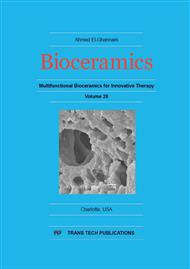[1]
S. Takagi, L.C. Chow, K. Ishikawa, Formation of hydroxyapatite in new calcium phosphate cements, Biomaterials 19 (1998) 1593-1599.
DOI: 10.1016/s0142-9612(97)00119-1
Google Scholar
[2]
X. Zhonglin, H. Zhang, A. Jin, Y. Jiandong, R. Li, A. Jun, F. Wei, L. Xiaoyong, Correlation between degradation and compressive strength of an injectable macroporous calcium phosphate cement, J. Alloy. Compd. 520 (2012) 220-225.
DOI: 10.1016/j.jallcom.2012.01.022
Google Scholar
[3]
A. Bigi, I. Cantelli, S. Panzavolta, K. Rubini, α-Tricalcium phosphate-gelatin composite cements, J. Appl. Biomater. Biom. 2 (2004) 81-87.
Google Scholar
[4]
W. Tingting, S. Haishan, Y. Jiandong, Effect of PLGA/lecithin hybrid microspheres and β- tricalcium phosphate granules on the physicochemical properties, in vitro degradation and biocompatibility of calcium phosphate cement, Royal Society of Chemistry 5 (2015).
DOI: 10.1039/c5ra06861d
Google Scholar
[5]
K. Kiminami, K. Matsuoka, K. Nagata, T. Konishi, M. Honda, G. Hayashida, K. Nakano, M. Nagaya, H. Arimura, H. Nagashima, M. Aizawa, Development of bioresorbable calcium-phosphate cements hybridized with gelatin particles and their in vivo evaluation using pig's tibia model, Key Eng. Mater. 631 (2015).
DOI: 10.4028/www.scientific.net/kem.631.397
Google Scholar
[6]
T. Konishi, S. Takahashi, Z. Zhuang, K. Nagata, M. Mizumoto, M. Honda, Y. Takeuchi, H. Nagashima, M. Aizawa, Biodegradable β-tricalcium phosphate cement with anti-washout property based on chelate-setting mechanism of inositol phosphate, J. Mater. Sci.: Mater. Med. 24 (2013).
DOI: 10.1007/s10856-013-4903-8
Google Scholar
[7]
T.H. Dao, Polyvalent cation effects on myo-inositol hexakis dihydrogen phosphate enzymatic dephosphorylation in dairy waste water, J. Environ. Qual. 32 (2003) 694-701.
DOI: 10.2134/jeq2003.6940
Google Scholar
[8]
C.J. Martin, W.J. Evans, Phytic acid-metal ion interractions. II. The effect of pH on Ca(II) binding, J. Inorg. Biochem., 27 (1986) 17-30.
DOI: 10.1016/0162-0134(86)80105-2
Google Scholar
[9]
M. Aizawa, T. Konishi, M. Honda, M. Matsumoto, Relationship between bioresorption and solubility in vitro of chelate-setting calcium-phosphate cements - verification on the basis of JIS T 0330-3 Bioceramics-Part 3: Testing method of measuring dissolution rate of calcium phosphate ceramics, - J. Soc. Inorg. Mater. Jpn., 22 (2015).
DOI: 10.4028/www.scientific.net/kem.758.194
Google Scholar
[10]
T. Konishi, M. Honda, T. Yoshioka, S. Hayakawa, M. Aizawa, Preparation of α-tricalcium phosphate powders surface-modified with inositol phosphate for cement fabrication, Key Eng. Mater. 631 (2015) 113-118.
DOI: 10.4028/www.scientific.net/kem.631.113
Google Scholar
[11]
Y. Öztürkmen, M. Canıklıoğlu, M. Karamehmetoğlu, E. Şükür, Calcium phosphate cement augmentation in the treatment of depressed tibial plateau fractures with open reduction and internal fixation, Acta. Orthop. Traumatol. Ture. 44 (2010) 262-269.
DOI: 10.3944/aott.2010.2406
Google Scholar
[12]
E. Fernández, M.P. Ginebra, M.G. Boltong, R.M.H. Verbeeck, J.A. Planell, Kinetic study of the setting reaction of a calcium phosphate bone cement, J. Biomed. Mater. Res. 32 (1996) 367-374.
DOI: 10.1002/(sici)1097-4636(199611)32:3<367::aid-jbm9>3.0.co;2-q
Google Scholar
[13]
H. Manabe, T. Konishi, M. Mizumoto, M. Honda, M. Aizawa, In vitro bioresorbability of chelate-setting cements with various calcium-phosphate phases, phosphorous Res. Bull., 26 (2012) 105-108.
DOI: 10.3363/prb.26.105
Google Scholar


